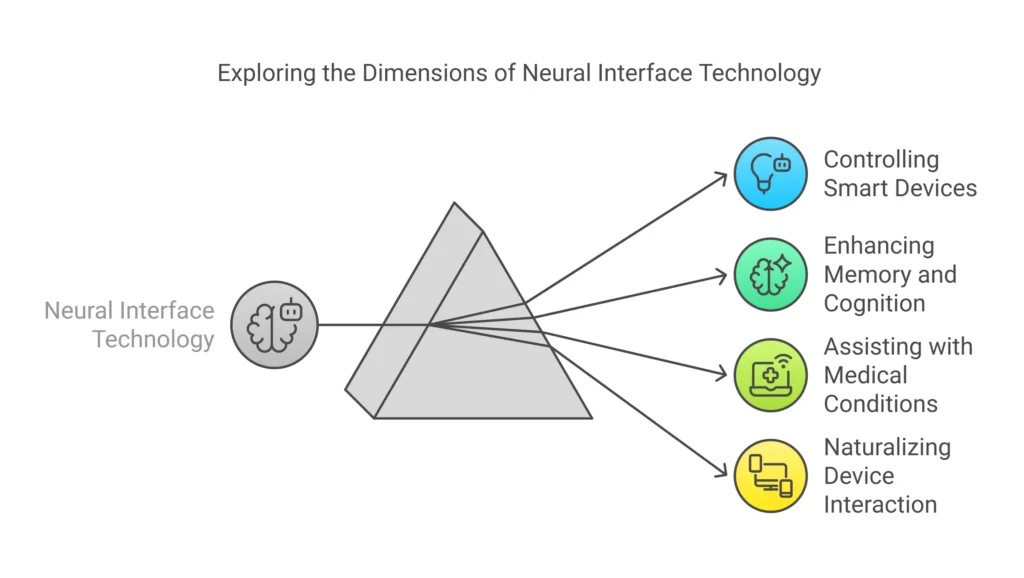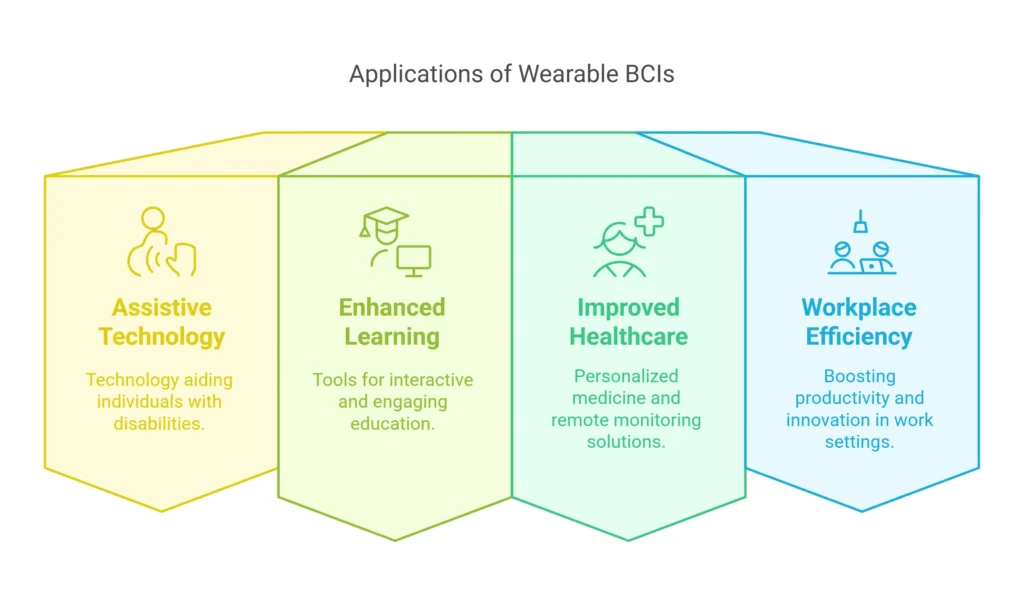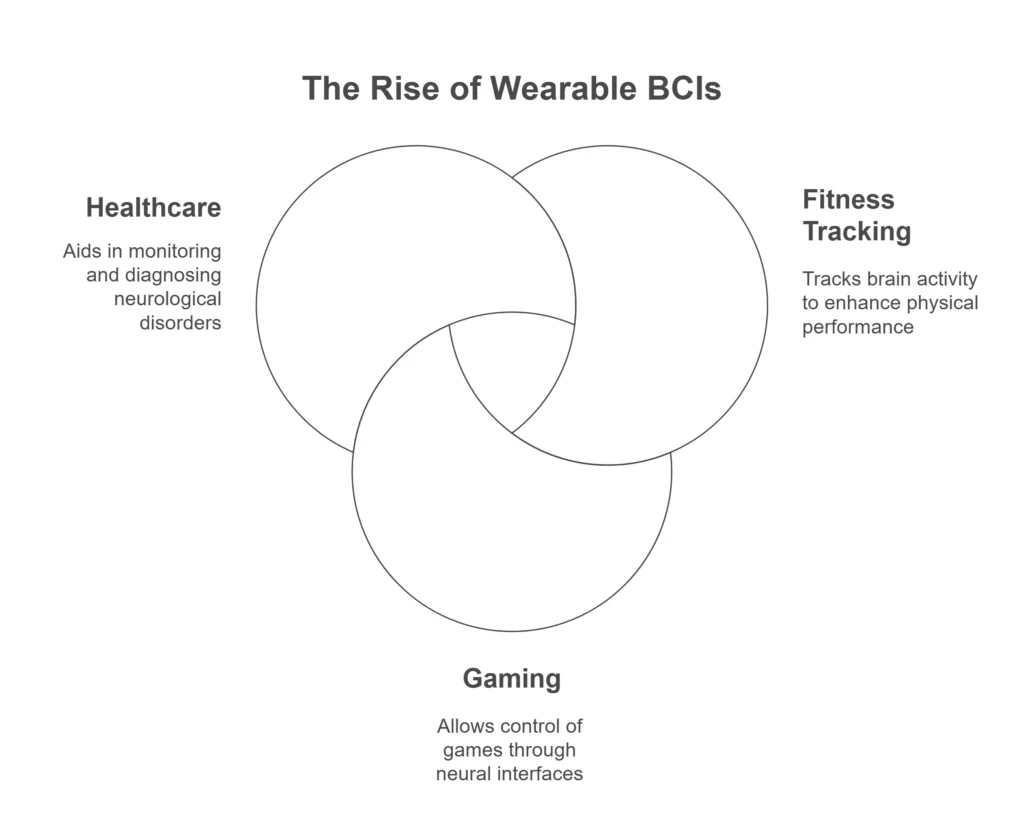Over 75% of Americans have a smartwatch. The latest in wearable BCI technology is changing how we use them. Now, we can control our smartwatches with just our thoughts.

Wearable BCI breakthroughs are leading to a new way of controlling smartwatches. Users can now interact with their devices using their brain signals. This technology is set to change how we use our smartwatches, making it easier to get information and track fitness goals.
Key Takeaways
- Wearable BCI breakthroughs are enabling thought-controlled smartwatches
- Neural interface innovations are transforming the way we interact with smartwatches
- 75% of Americans own a smartwatch, making it a significant market for wearable BCI technology
- Thought-controlled smartwatches have the ability to revolutionize how we access information and track fitness goals
- Wearable BCI technology is poised to make smartwatch interaction more intuitive and seamless
- Mind over machine is becoming a reality with the rise of neural interface innovations in wearable tech
Wearable BCIs: The Rise of Thought-Controlled Smartwatches
Brain-computer interface technology has changed how we use smartwatches. Now, we can control them with our minds. This big step forward has made controlling devices easier and more personal. It also gives companies a unique edge in the market.
The world of wearable BCIs is growing fast. Big companies are spending a lot on research. This has led to some exciting changes:
- EEG sensors are getting better, making it easier to read brain signals.
- Machine learning is improving, helping devices understand brain signals better.
- Devices are becoming more user-friendly, with better feedback and interfaces.
Wearable BCIs could change how we use our devices a lot. Smartwatches could become even more tailored to us. As the tech gets better, we’ll see even more cool things. This will make wearable BCIs even more popular, giving companies a unique advantage.
| Company | Device | Features |
| Neuralink | Brain-Machine Interface | High-bandwidth neural interface, real-time signal processing |
| Apple | Apple Watch | EEG sensors, machine learning-powered signal analysis |
| Google Pixel Watch | Advanced gesture recognition, seamless control with brain signals |
Breaking Down Neural Interface Technology
Neural interface technology is quickly growing. It combines cognitive wearables with smart devices. This mix of neuroscience and tech lets people control devices with their minds. It’s changing how we use smart devices, making them easier to use.

The idea of cognitive wearables is to blend neuroscience with tech. It uses brain-computer interface (BCI) tech. This tech reads brain signals and turns them into actions for devices. Soon, we might control smartwatches, phones, and computers just with our thoughts.
Neural interface tech has many uses. Here are a few:
- Controlling smart devices with thoughts
- Improving memory and thinking
- Helping with conditions like paralysis and epilepsy
- Making device interaction more natural
In short, neural interface tech is changing how we use smart devices. It’s making them more natural and easy to use. As it grows, we’ll see even more cool uses for cognitive wearables and neural tech.
Smart Device Integration with Brain Signals
Technology is getting better, and linking smart devices to brain signals is key. This new way lets users control smartwatches with their thoughts. It’s changing how we use our devices.
Signal processing and pattern recognition are at the heart of this tech. Advanced algorithms decode brain signals, linking them to commands. This lets users do tasks easily. Quick neural data analysis is also vital for fast and accurate responses.
Optimizing User Experience
Smartwatch makers are working hard to make things better for users. They’re creating easy-to-use interfaces. This makes smartwatches a big part of our daily lives.
- Thought-driven commands for easy navigation
- Real-time neural data analysis for accurate responses
- Intuitive interfaces for a seamless user experience
These features make smartwatches powerful and handy. As tech keeps improving, we’ll see even more cool uses of brain-computer tech.
Revolutionary Applications in Daily Life
Wearable BCIs are changing the game in many fields. They promise to make a big difference in healthcare and education. Imagine controlling devices with just your thoughts. It’s a game-changer for how we interact with the world.

Some cool uses for wearable BCIs include:
- Assistive technology for people with disabilities
- Enhanced learning experiences through interactive education tools
- Improved healthcare outcomes through personalized medicine and remote patient monitoring
- Increased productivity and efficiency in the workplace
By improving neural interface tech, we open up new possibilities. This tech makes our society more inclusive and efficient. As we keep exploring, we’ll see big changes in our daily lives.
Neural interface tech will change many industries. It will make our world more efficient and connected. The uses for wearable BCIs are endless. As we develop this tech, we’ll see huge changes in how we live and work.
| Industry | Potential Application |
| Healthcare | Remote patient monitoring, personalized medicine |
| Education | Interactive education tools, enhanced learning experiences |
| Workplace | Increased productivity, efficiency, and innovation |
The Science Behind Thought-Driven Commands
Wearable bci breakthroughs have led to thought-controlled smartwatches. These devices are changing how we use technology. Advances in neural pattern mapping and machine learning make it possible.
Neural pattern mapping creates a map of a user’s brain activity. This map helps identify specific thoughts or commands. Electroencephalography (EEG) or other BCI technologies are used for this.
Machine learning algorithms help wearable devices learn brain patterns. This allows for accurate and efficient control of smartwatches.
Key Factors in Thought-Driven Commands
- Neural pattern mapping: creating a unique map of a user’s brain activity
- Machine learning integration: enabling devices to learn and recognize brain patterns
- Response time optimization: ensuring seamless and efficient control of smartwatches
The rise of thought-controlled smartwatches is a big step in wearable bci breakthroughs. As technology gets better, we’ll see more uses of thought-driven commands in our lives.
Market Impact and Consumer Adoption
The market impact of wearable BCIs is huge. Mind over machine innovations are driving growth. As people learn about neural interface tech, more are using it. This tech could change how we use devices, and companies are spending a lot on research.

Wearable BCIs stand out because they give real-time feedback and improve user experience. They have uses beyond just smartwatches. For instance, they’re used in fitness, gaming, and healthcare. Here are some ways they’re being used:
- Fitness tracking: They track brain activity to give insights into physical performance.
- Gaming: Neural tech lets users control games with their minds.
- Healthcare: They help monitor and diagnose conditions like epilepsy and Parkinson’s.
Market trends show a move towards better and easier-to-use wearable BCIs. As exploring neural interface innovations in wearable tech keeps improving, we’ll see more cool uses. Wearable BCIs are set to change how we interact with devices, impacting the market and adoption.
| Application | Description |
| Fitness Tracking | Track brain activity and physical performance |
| Gaming | Control games with neural interface technology |
| Healthcare | Monitor and diagnose neurological disorders |
Overcoming Technical Challenges
The smartwatch evolution is making big strides by using brain signals for control. But, it faces some big technical hurdles. One major issue is battery life and how to manage power. To solve this, makers are looking into new ways to save energy and manage power better.
Getting brain signals right is also key. Signal processing and pattern recognition are vital for making sure brain signals work as they should. The goal is to make devices respond smoothly to our thoughts. This is being done by using smart algorithms and learning from how we use devices.
Some important things to work on include:
- Improving battery life and power use
- Boosting signal accuracy and reliability
- Keeping user data safe and secure
By tackling these challenges, the smartwatch evolution can keep improving. This means we’ll get to control our devices in a more natural and intuitive way.
Future Development Roadmap
The future of wearable BCIs is bright, with a chance to stand out in the market. As tech gets better, we’ll see more advanced seo strategies for next-gen thought-control devices. These strategies will be key in growing the industry.
Improving signal accuracy and reliability, and making user experience better are key goals. By doing this, makers can make devices that work better and are easier to use. This will help more people use them, boosting the market.
Some cool uses for wearable BCIs could be:
- Healthcare: tracking and treating health issues
- Education: making learning better and improving grades
- Gaming: creating more engaging and interactive games
As the field grows, we’ll see even more uses for wearable BCIs. By leading in seo strategies for next-gen thought-control devices, companies can stay ahead and lead the market.
Conclusion: The Dawn of Neural Wearable Technology
The arrival of cognitive wearables marks a new era. It brings together neuroscience and smart devices. This change lets us control our digital world with just our thoughts.
Wearable brain-computer interfaces (BCIs) are amazing. They let us easily use smart devices and change how we work and live. As we learn more, we’ll see even more ways these devices will change our lives.
The future of cognitive wearables looks bright. This technology is starting a new chapter in how we use computers. It will make our lives better, help us work more efficiently, and assist people with disabilities. The future is here, and it’s changing how we see and use technology.